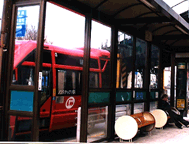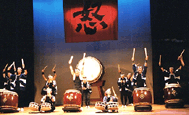Road of Human Rights and Taiko Completed
 A town project was initiated in 2002 to design a "Road of Human Rights and Taiko" in Osaka City's Naniwa Buraku community to represent its 300-year history and community pride as one of the largest historical centers of leather trade and taiko (Japanese drum) production. A committee, composed of the Osaka City Government, the Naniwa Branch of the Buraku Liberation League, a local railway company, the Osaka Taiko Industry Association, and various experts, was formed to examine the design proposals for the Road and a series of discussions was held over the following year. A design for the Road was eventually agreed upon and construction and beautification work based upon it was completed in November 2003.
A town project was initiated in 2002 to design a "Road of Human Rights and Taiko" in Osaka City's Naniwa Buraku community to represent its 300-year history and community pride as one of the largest historical centers of leather trade and taiko (Japanese drum) production. A committee, composed of the Osaka City Government, the Naniwa Branch of the Buraku Liberation League, a local railway company, the Osaka Taiko Industry Association, and various experts, was formed to examine the design proposals for the Road and a series of discussions was held over the following year. A design for the Road was eventually agreed upon and construction and beautification work based upon it was completed in November 2003.
The overall project incorporates 8 zones, such as "taiko makers" and "human rights culture", within the Road, which runs nearly 500 meters from the Ashiharabashi railway station to the Osaka Human Rights Museum (Liberty Osaka). Stone monuments, information boards and taiko-shaped benches have been created along the Road to attract passersby.
It is believed that the Naniwa Buraku community, formerly called Watanabe Village, was formed by people who were engaged in cleaning, the disposal of dead animals and leather manufacturing. The Village was repeatedly forced to shift location, but 300 years ago the community finally settled into its current location. Traditional techniques of leather production and taiko making have handed down within the community through successive generations.
Young Taiko Performers' Passion Gives Birth to Town Project
It was the formation of a taiko (Japanese drum) performance group called "Ikari" in Naniwa Buraku community that led to the creation of a local road design project to represent respect for human rights and the community's history.
 Ikari was formed almost two decades ago by a group of children who participated in the "Taiko Concert Bridging Okinawa and Osaka" and were deeply moved by the Okinawan children's performance. They kept practicing taiko even after the concert finished and formed the group Ikari. Participation in the group improved their skills and earned them a high reputation so that they now hold more than 30 concerts every year both within Japan and in other countries around the world. Ikari currently has 23 members, most of who originate from the Naniwa Buraku community, and their ages range from high school aged students to those in their 30's.
Ikari was formed almost two decades ago by a group of children who participated in the "Taiko Concert Bridging Okinawa and Osaka" and were deeply moved by the Okinawan children's performance. They kept practicing taiko even after the concert finished and formed the group Ikari. Participation in the group improved their skills and earned them a high reputation so that they now hold more than 30 concerts every year both within Japan and in other countries around the world. Ikari currently has 23 members, most of who originate from the Naniwa Buraku community, and their ages range from high school aged students to those in their 30's.
Naoya Tanimoto, the former leader of Ikari, says that he used to be hesitant to admit to Naniwa Buraku community as being his place of origin. "However, my pride in my origins grew as I played taiko and worked towards becoming skilled enough to represent our taiko traditions and culture."
Jun Nishihata, the current leader of Ikari, places high importance on playing taiko in local schools. He said, "I play taiko thanks to the community that has supported Ikari. I hope that the community's younger generation will develop an interest in taiko and become our successors." Local residents supported Ikari, which used to practice with old tires and large buckets, by donating a big taiko worth 10 million yen.
Mr. Asai, the Secretary-General of the Naniwa Branch of the Buraku Liberation League, reports that "Ikari has fostered pride in our community through taiko performance. While there are both supportive and unsupportive residents, it has driven us to highlight the community's industry and culture in town projects." Professor Kenji Nakao, who studies Buraku issues, stated that it is significant to incorporate community pride into Buraku community development in order to confront discrimination against Buraku and change the stereotyped image of poverty.

(Source: Kaiho Shimbun (Liberation News) No. 2154, January 26, 2004 and Asahi Shimbun (newspaper) April 17, 2003.)
